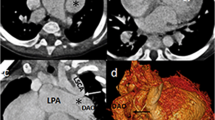Abstract
Background
Cine angiography and echocardiography have been utilized to diagnose congenital aortic arch anomalies. However, the visualization of great vessels by echocardiography is limited, while cine angiography requires cardiac catheterization with ionizing radiation. Contrast-enhanced magnetic resonance angiography (MRA) is a noninvasive modality suitable for visualization of congenital aortic arch anomalies.
Objective
To evaluate the utility of contrast-enhanced MRA in the diagnosis of persistent fifth aortic arch, a rare congenital aortic arch anomaly, and to compare the diagnostic accuracy of MRA with that of echocardiography and cine angiography.
Materials and methods
In four pediatric patients, contrast-enhanced MRA studies were performed for diagnosing persistent fifth aortic arch. The findings of MRA were compared with echocardiographic findings and confirmed by cine angiography and operation.
Results
Transthoracic surface echocardiography noted an aberrant vessel arising from the ascending aorta in two of four patients; the etiology of this vessel was uncertain. In the other two patients a diagnosis of coarctation was made. Of the four patients, only one was diagnosed with interruption of the aortic arch. Contrast-enhanced MRA clarified uncertain echocardiographic findings, enabling the correct diagnosis of persistent fifth aortic arch with fourth aortic arch interruption in all four patients.
Conclusion
Contrast-enhanced MRA is a safe, accurate, and fast imaging technique for the evaluation of persistent fifth aortic arch and may obviate the need for conventional cine angiography. Cardiac catheterization may be reserved for some types of complicated congenital heart disease and for obtaining hemodynamic information.





Similar content being viewed by others
References
Van Praagh R, Van Praagh S (1969) Persistent fifth arterial arch in man: congenital double-lumen aortic arch. Am J Cardiol 24:279–282
Congdon ED (1922) Transformation of the aortic arch system during the development of the human embryo. Contrib Embryol 14:47–110
Izukawa T, Scott ME, Durrani F et al (1973) Persistent left fifth aortic arch in man. Report of two cases. Br Heart J 35:1190–1195
Lambert V, Blaysat G, Sidi D et al (1999) Double-lumen aortic arch by persistence of fifth aortic arch: a new case associated with coarctation. Pediatr Cardiol 20:167–169
Donti A, Soavi N, Sabbatani P (1997) Persistent left fifth aortic arch associated with tetralogy of Fallot. Pediatr Cardiol 18:229–231
Yoo SJ, Moes CA, Burrows PE et al (1993) Pulmonary blood supply by a branch from the distal ascending aorta in pulmonary atresia with ventricular septal defect: differential diagnosis of fifth aortic arch. Pediatr Cardiol 14:230–233
Lim C, Kim WH, Kim SC et al (2002) Truncus arteriosus with coarctation of persistent fifth aortic arch. Ann Thorac Surg 74:1702–1704
DiBardino DJ, Fraser CD Jr (2004) Persistent left fifth aortic arch. Ann Thorac Surg 78:346
McMahon CJ, Kertesz NJ, Vick GW (2002) Delineation of persistent fifth aortic arch using magnetic resonance angiography. Cardiol Young 12:484–485
Chiu CC, Wu JR, Chen HM (2000) Persistent fifth aortic arch: an ignored and underestimated disease. Jpn Heart J 41:665–671
Suda K, Matsumura M, Matsumoto M (2004) Balloon dilation of the stenotic fifth aortic arch in a newborn with double lumen aortic arch. Heart 90:245
Wang JN, Wu JM, Yang YJ (1999) Double-lumen aortic arch with anomalous left pulmonary artery origin from the main pulmonary artery – bilateral persistent fifth aortic arch – a case report. Int J Cardiol 69:105–108
Yang SG, Fogel MA, Stephens P Jr et al (2003) Noninvasive imaging of isolated persistent fifth aortic arch. Pediatr Cardiol 24:179–181
Parmar RC, Pillai S, Kulkarni S et al (2004) Type I persistent left fifth aortic arch with truncus arteriosus type A3: an unreported association. Pediatr Cardiol 25:432–433
Isomatsu Y, Takanashi Y, Terada M et al (2004) Persistent fifth aortic arch and fourth arch interruption in a 28-year-old woman. Pediatr Cardiol 25:696–698
Acknowledgement
We wish to thank Mr. Hong Zhang for the wonderful schematic drawings.
Author information
Authors and Affiliations
Corresponding author
Rights and permissions
About this article
Cite this article
Zhong, Y., Jaffe, R.B., Zhu, M. et al. Contrast-enhanced magnetic resonance angiography of persistent fifth aortic arch in children. Pediatr Radiol 37, 256–263 (2007). https://doi.org/10.1007/s00247-006-0385-x
Received:
Revised:
Accepted:
Published:
Issue Date:
DOI: https://doi.org/10.1007/s00247-006-0385-x




